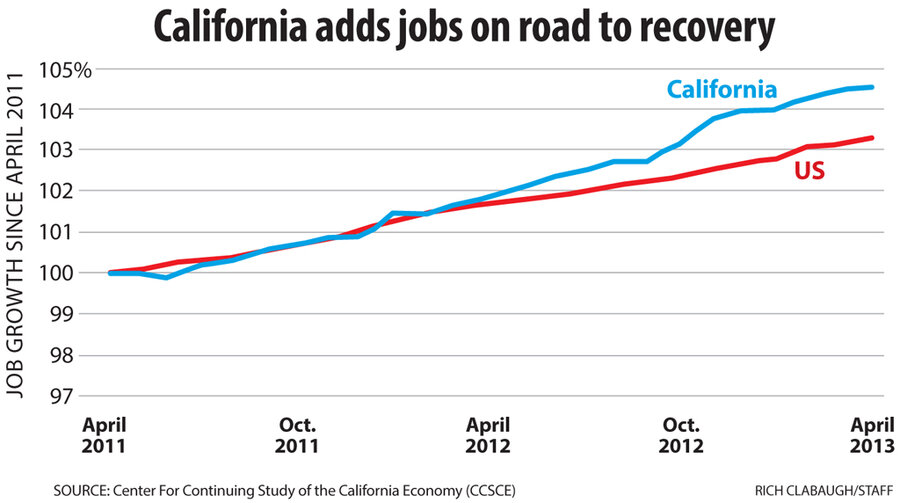California economy is on the comeback trail. Can America follow?
Loading...
| Los Angeles
The addition of hundreds of thousands of new jobs in the last two years and a soaring real estate market are leading the economic recovery in California, among the states that had been hardest hit by the recession.
But while California’s sheer size means its recovery is good news for the nation’s economy as a whole, many of the reasons experts cite for the turnaround are particular to the Golden State – including its geographic location, strong technology sector, and the quirks of its political leadership – meaning its success may not translate easily to other regions of the country.
And optimism about California’s recovery is somewhat tempered by the state’s severe, long-term fiscal challenges and the fact that two of the economic sectors fueling the jobs comeback – health care and trade – face uncertain futures, analysts say.
One indication of the rebound in the housing market is the dramatic year-to-year jump in the median price of homes in California’s six southern counties – the state’s most populous. According to La Jolla-based DataQuick, home prices were 28.3 percent higher in June than they were a year before, the fastest such rise in 10 years. That puts the median home price at $385,000, up from $300,000 in June, 2012.
And, after having the second highest unemployment rate in the nation for nearly two years – it hovered roughly at 10 percent – California’s current rate of 8.5 percent is now ninth in the country. Between April 2011 and April 2013, the state added 639,600 non-farm wage and salary jobs, or more than 300,000 per year. The state added another 16,800 jobs in May and 30,200 in June.
“The bottom line is that the technology sector in San Francisco and San Diego has been soaring and everyone has been building new commercial space,” says Steve Levy, president of the Center for the Continuing Study of the California Economy (CCSCE). “All of the data is showing California outpacing the nation in jobs for 24 months.”
He says all of this data is combating a very negative national view of California, which was having the tangible effect of causing businesses to choose not to move here or businesses here to be driven elsewhere for image reasons.
Mr. Levy says that an absence of negatives and a turnaround in such fields as trade and tourism – driven somewhat by being on the Pacific Rim as opposed to the Atlantic, which is connected by sea to ailing Europe – has helped.
“California is also situated well between Mexico and Canada, which are also doing much better,” says Levy.
Several analysts also are giving Gov. Jerry Brown credit for doing what only someone with his long experience in government could do.
“This comeback is for real here, but I’m not sure how translatable it is to other states,” says Barbara O’Connor, director emeritus of the Institute for the Study of Politics and Media at California State University, Sacramento.
She ticks off a list of conditions she says are unique to Governor Brown’s political situation of the moment – minimizing raises in state government wages, cutting contracts, dealing with redevelopment agency restructuring, and using rainy day funds, with the support of a strong, Democratic two-house majority – as driving confidence after years of missed budget deadlines. And she says Brown’s place in the twilight of his political career – aged 74, a second time governor after serving as attorney general and mayor of Oakland – have positioned him perfectly for this moment.
“He’s doing things that other governors would like to do but can’t, because they are younger and running for election later,” she says. “He’s drawing on his experience as a mayor for what cities need, and as governor and attorney general before.”
Other analysts say that despite Jerry Brown’s feisty tone and serial grumpiness, his ability to get things done has turned attitudes around for the better. That could change depending on how much Brown maintains his focus and doesn’t get caught up in projects that could derail the current momentum.
Wild cards include his plan to build two massive tunnels to move water from north to south – at a pricetag of $25 billion – and an on-again-off-gain high-speed rail, at $68 billion.
“We have a governor who likes to dream big and talk big ... someone who likes to stretch the conventional wisdom around how Silicon Valley moves information and ideas; how Hollywood moves culture; and how we build infrastructure for the 21st century,” says David McCuan, a political science professor at Sonoma State University.
“He'll have to attack some golden eggs to do this, which will affect his relationship with public employee labor unions and others,” he says. It’s not clear, Professor McCuan adds, how far Democrats in the Legislature will go for him or how popular he is with them, but in the end, “he is their guy and so they want to see him succeed.”
Still others say the job and other indicators are good news, but the state is still a long way from full recovery.
“The government sector is still living well beyond its means with billions in unfunded pension liabilities and a workforce demanding more in salary and benefits to offset the last few lean years,” says Michael Shires, a professor of public policy at Pepperdine University.
“Momentum is still not there to drive the recovery forward. The state’s eventual recovery is also dependent on a national economy that is currently propped by aggressive Fed policies and a relatively calm international finance scene. Disruptions in either of these could easily send the trend the other way.”







